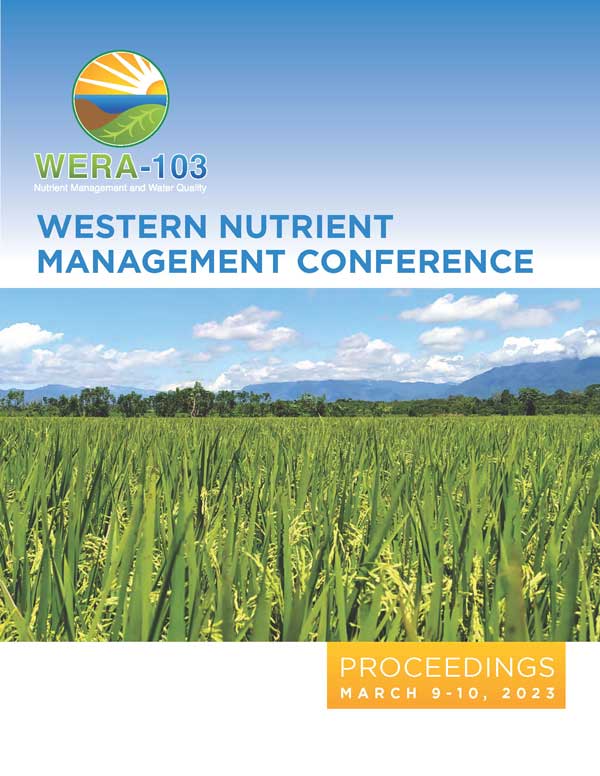Download the Conference Proceedings
Proceedings
Authors
| Filter results8 paper(s) found. |
|---|
1. Effects of Commercial Organic and Cyanobacterial Fertilizers on Instantaneous Water Use Efficiency in Drip Irrigated Organic Sweet CornWater and fertilizers are applied to maintain crop growth, yield, and quality. Nitrogen (N) fertilizer plays a crucial role in crop growth and yield development of sweet corn (Zea mays). Organic growers often use commercial organic animal- based fertilizers which vary in nutrient composition, forms of available N (NH4+- N and NO3--N), and have high transportation costs. Alternatively, cyanobacteria can be grown on-site as a source of N. Cyanobacteria haves unique dual properties because they... J. G. davis, A. Sukor, C. Ramsey |
2. Effects of Enhanced Mixing and Minimal Co2 Supplementation on Biomass and Nitrogen Concentration in a Nitrogen-fixing Anabaena Sp. Cyanobacteria Biofertilizer Production CultureNitrogen-fixing cyanobacteria are attractive as a nitrogen fertilizer because they are ubiquitous in nature and have minimal nutrient requirements. Our lab is scaling up production of a local strain of the nitrogen-fixing cyanobacterium Anabaena sp. in on-farm open raceways to determine its exonomic ppotential as a nitrogen fertilizer for horticultural crops. Our goal is to increase productivity in an organically certifiable growth medium above the current two week batch production levels... J. G. davis, J. Wenz, H. Storteboom |
3. Effect of Liquid Organic Fertilizers and Seaweed Extract on Daucus Carota Var. Sativus Growth CharacteristicsCommon N fertilizers used in organic production are often energy intensive to produce and expensive to transport. Cyanobacteria fertilizer produced on-farm could decrease impacts on the environment as well as production costs for organic farmers. In addition, cyanobacteria fertilizer could perform similarly to products marketed to increase production via plant growth hormones such as seaweed extract. The effects of common organic fertilizers as well as organic liquid cyanobacteria fertilizer on... J. G. davis, A. Wickham |
4. Variability of Manure Nutrient Content and Implications for Manure Sampling ProtocolThe variability of manure nutrient levels within and across farms makes manure sampling and development of reliable tabular values challenging. The chemical characteristics of beef, dairy, horse, sheep, and chicken solid manures in Colorado were evaluated by sampling six to ten different livestock operations for each manure type and comparing the results to values found in the literature. Due to the semi-arid climate of Colorado, manure tends to be drier and have lower ammonium (NH4-N) levels... J. G. davis, K. Iversen, M. Vigil |
5. Determining Plant Available Nitrogen from Manure and Compost Topdressed on an Irrigated PastureComposting manure is a practice that is gaining acceptance as an environmentally sound manure management practice at large animal production operations. Composting produces a value-added product that enhances the fertility and physical properties of soil. During the composting process, nitrogen and phosphorus in the original feedstocks are converted through microbial activity into predominantly stable organic compounds, lessening the risk of loss of these nutrients into the environment. Compost... J. G. davis, T. Bauder, K. Corwin doesken, A. Elliott |
6. Best Management Practices (Bmps) for Ammonia Emissions Reduction from Animal Feeding Operations: a Colorado Case StudyAmmonia emissions from agriculture are a growing concern, in particular, in Colorado where nitrogen deposition in Rocky Mountain National Park has highlighted public concerns. Due to the high level of political pressure on agriculture to reduce its emissions, the agricultural community in Colorado has recently developed a Rocky Mountain National Park Ag Strategy for decreasing ammonia emissions from agriculture and nitrogen deposition in the park. The strategy includes the completion of a thorough... J. G. davis, A. Elliott, N. Marcillac, J. Pritchett, C. Stewart, A. Mink |
7. Reducing Dairy Effluent Phosphorus Content Through Struvite ProductionForced precipitation of struvite (magnesium ammonium phosphate hexahydrate, MgNH4PO46H2O) in wastewater treatment has recently received increased attention as a method of phosphorus (P) recycling. Dairy lagoon P concentrations can be lowered, and the recovered struvite has the potential to be marketed and used as a fertilizer. Struvite may even be useful in organic production on calcareous soils, where rock P (PR) is not an option. A new organic treatment method, based on an existing... J. G. davis, J. Ippolito, M. Massey, R. Sheffield |
8. Predicting Phosphorus Runoff from Calcareous SoilsStudies have shown that as extractable soil P levels increase, runoff P levels also increase. This relationship has been found on many different soils, but tends to be unique for each soil series. Very little research exists evaluating this relationship in calcareous soils. The objectives of this study were to determine soil series specific relationships between soil test phosphorus (STP) and runoff P for three calcareous soils, to compare the use of different soil extractants for runoff P prediction... J. G. davis, R. Schierer, J. Zumbrunnen |
